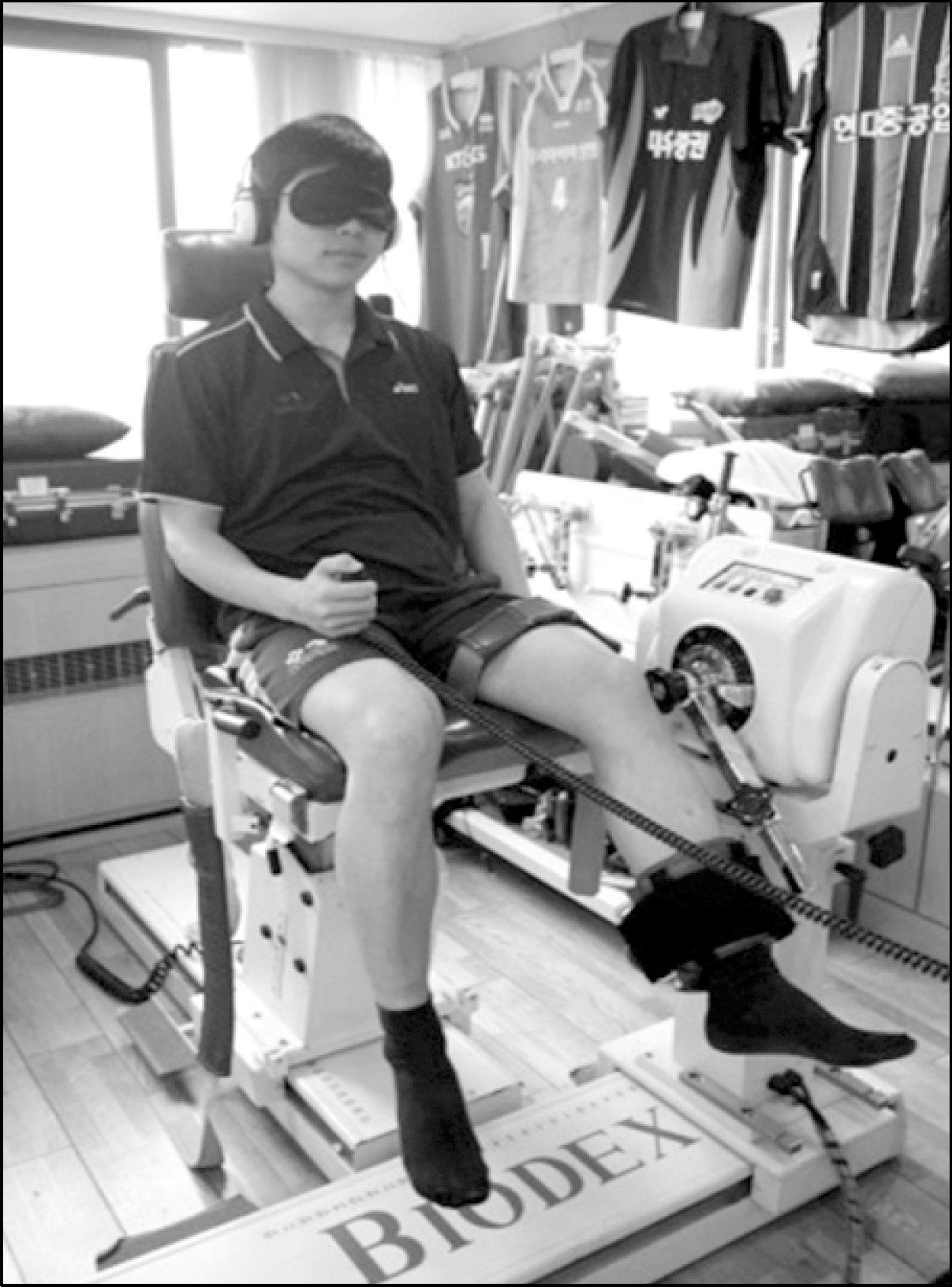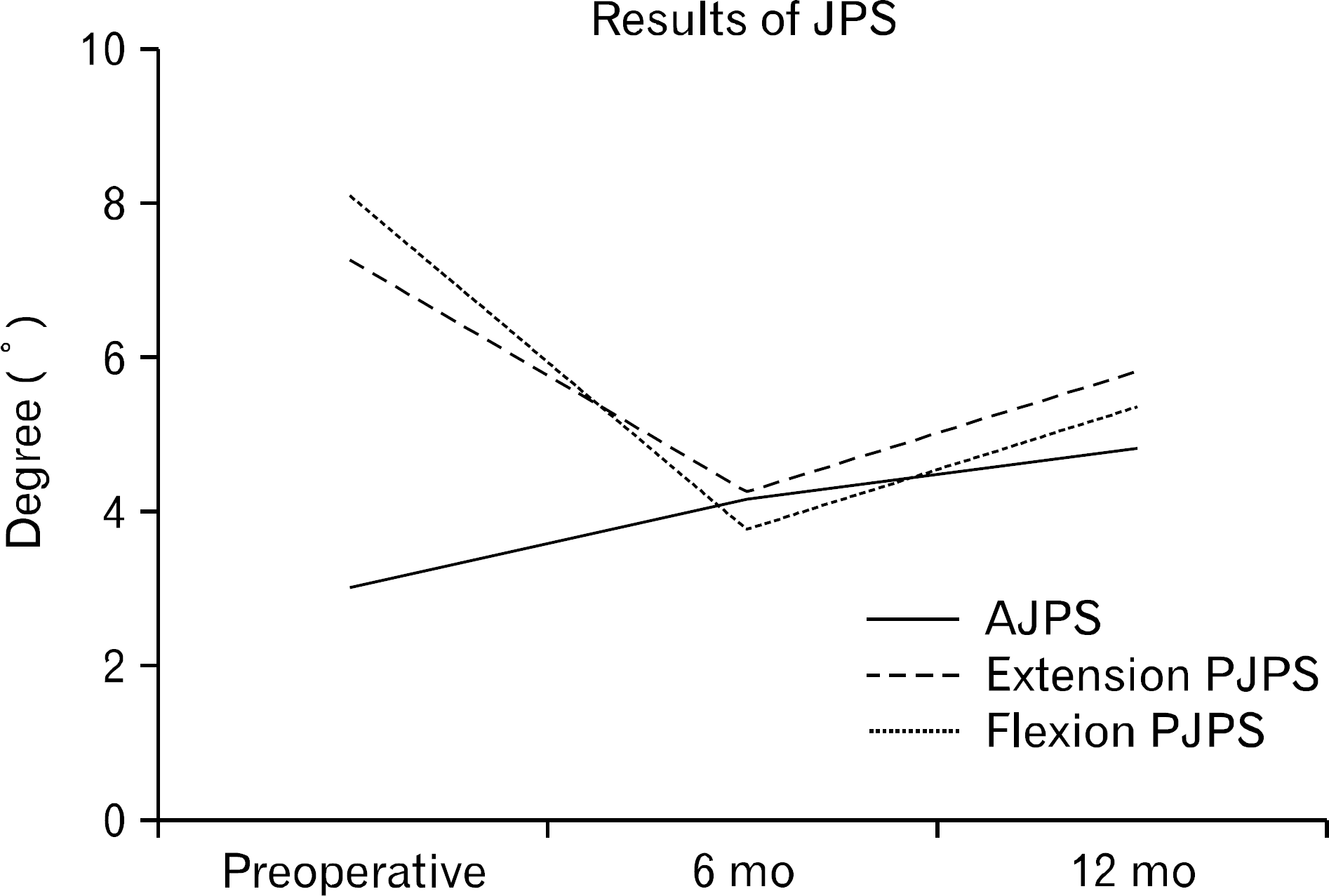Abstract
We designed a study to evaluate the change of the proprioceptive function with joint position sense (JPS) during 1 year follow-up period after anterior cruciate ligament (ACL) reconstruction using hamstring autograft. Thirty-eight men who underwent ACL reconstruction were tested for International Knee Documentation Committee subjective knee score, Tegner activity score, Lysholm score, KT-2000 arthrometer, isokinetic strength test, functional performance test (carioca, co-contraction, shuttle run test, one-hop test) and JPS at preoperation, 6 months, and 12 months postoperation. The contralateral healthy knee was used as control. There were no significant differences of JPS between the involved knee and healthy knee at any time period. Repeated measures analysis of variance of the active JPS revealed that there was no significant difference during the follow up periods. The change patterns of passive JPS of extension and flexion were out of accordance with the improving clinical status following ACL reconstruction. Most of the clinical parameters did not show the significant correlation with active and passive JPS at any time period. In conclusion, JPS does not reflect the change of proprioceptive function following ACL reconstruction.
Go to : 
References
1. Angoules AG, Mavrogenis AF, Dimitriou R, et al. Knee proprioception following ACL reconstruction; a prospective trial comparing hamstrings with bone-patellar tendon-bone autograft. Knee. 2011; 18:76–82.

2. Reider B, Arcand MA, Diehl LH, et al. Proprioception of the knee before and after anterior cruciate ligament reconstruction. Arthroscopy. 2003; 19:2–12.

3. Carter ND, Jenkinson TR, Wilson D, Jones DW, Torode AS. Joint position sense and rehabilitation in the anterior cruciate ligament deficient knee. Br J Sports Med. 1997; 31:209–12.

4. Solomonow M, Baratta R, Zhou BH, et al. The synergistic action of the anterior cruciate ligament and thigh muscles in maintaining joint stability. Am J Sports Med. 1987; 15:207–13.

5. Wojtys EM, Huston LJ. Neuromuscular performance in normal and anterior cruciate ligament-deficient lower extremities. Am J Sports Med. 1994; 22:89–104.

6. Mir SM, Hadian MR, Talebian S, Nasseri N. Functional assessment of knee joint position sense following anterior cruciate ligament reconstruction. Br J Sports Med. 2008; 42:300–3.

7. Ozenci AM, Inanmaz E, Ozcanli H, et al. Proprioceptive comparison of allograft and autograft anterior cruciate ligament reconstructions. Knee Surg Sports Traumatol Arthrosc. 2007; 15:1432–7.

8. Ochi M, Iwasa J, Uchio Y, Adachi N, Sumen Y. The regeneration of sensory neurones in the reconstruction of the anterior cruciate ligament. J Bone Joint Surg Br. 1999; 81:902–6.

9. Miura K, Ishibashi Y, Tsuda E, Okamura Y, Otsuka H, Toh S. The effect of local and general fatigue on knee proprioception. Arthroscopy. 2004; 20:414–8.

10. Corrigan JP, Cashman WF, Brady MP. Proprioception in the cruciate deficient knee. J Bone Joint Surg Br. 1992; 74:247–50.

11. Boerboom AL, Huizinga MR, Kaan WA, et al. Validation of a method to measure the proprioception of the knee. Gait Posture. 2008; 28:610–4.

12. Fridén T, Roberts D, Zätterström R, Lindstrand A, Moritz U. Proprioception after an acute knee ligament injury: a longitudinal study on 16 consecutive patients. J Orthop Res. 1997; 15:637–44.

Go to : 
 | Fig. 1.The evaluation of joint position sense was per-formed at 45 o in a sitting position. The subject has ear-plugs and blindfold covering his eyes14). |
 | Fig. 2.Results of JPS in ACL reconstructed knee. JPS: joint position sense, AJPS: active joint position sense, PJPS: passive joint position sense. |
Table 1.
Demographic data of the subjects
| Subjects | Age (y) | Height (cm) | Weight (kg) |
|---|---|---|---|
| n=38 | 28.5±8.3 | 174.5±5.4 | 78.5±9.9 |
Table 2.
Clinical results of the subjects
Table 3.
The results of joint position sense test by follow-up period
| Variable | Preoperative | 6 mo | 12 mo | p-value∗ |
|---|---|---|---|---|
| AJPS | 3.00±3.64 | 4.15±3.63 | 4.78±4.34 | 0.12 |
| Extension PJPS | 7.23±5.84 | 4.23±4.33 | 5.76±5.28 | |
| Flexion PJPS | 8.02±5.51 | 3.78±2.53 | 5.31±3.72 |
Table 4.
The difference of joint position sense between involved and uninvolved knee




 PDF
PDF ePub
ePub Citation
Citation Print
Print


 XML Download
XML Download